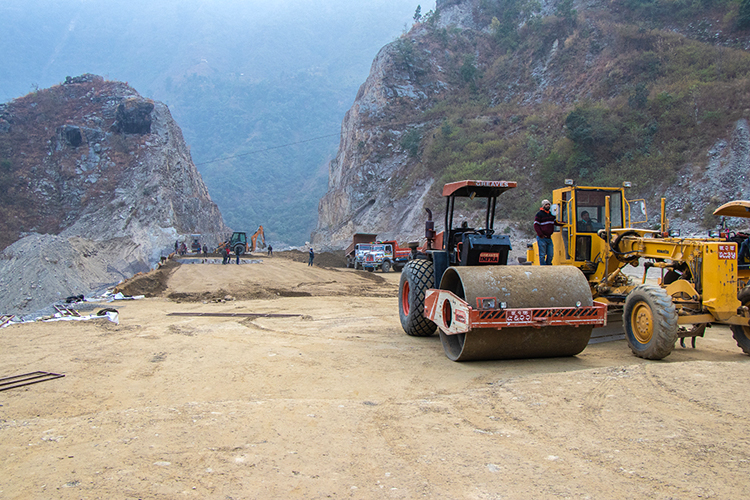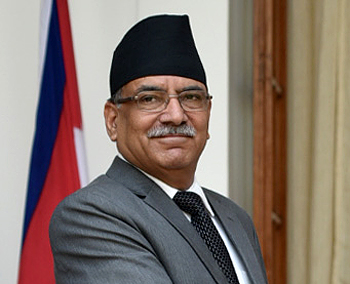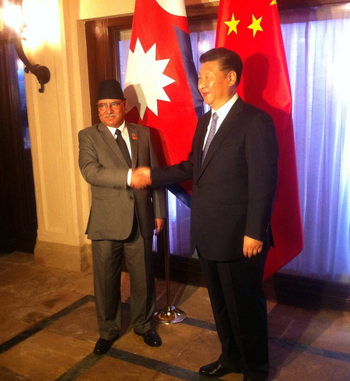INDIAN ARMED FORCES CHIEFS ON
OUR RELENTLESS AND FOCUSED PUBLISHING EFFORTS

SP Guide Publications puts forth a well compiled articulation of issues, pursuits and accomplishments of the Indian Army, over the years

I am confident that SP Guide Publications would continue to inform, inspire and influence.

My compliments to SP Guide Publications for informative and credible reportage on contemporary aerospace issues over the past six decades.
- Interim Defence Budget 2024-25 — An Analysis
- Union Defence budget 2024
- Indian Army: In quest of greater firepower and policy recommendations for gaps
- Indian Army Annual Press Conference 2024
- 6G will transform military-industrial applications
- Tata Boeing Aerospace Delivers 250 AH-64 Apache Fuselages, Manufactured in India
China in Southern Nepal
China has managed to install Prachanda as the third time Prime Minister of Nepal by some deft maneuverings behind the scenes. This is bad news for India.
 |
The Author is Former Director General of Information Systems and A Special Forces Veteran, Indian Army |

The Nepali Congress emerged as the single largest party winning 89 seats in the recent General Elections in Nepal to elect the 275 members of the House of Representatives; 165 members from single-member constituencies plus 110 members from a single nation-wide constituency. The five-party alliance led by the Nepali Congress that was ruling Nepal for the past one year secured 136 seats - just short of 138 for an absolute majority. In a meeting with Prime Minister Sher Bahadur Deuba after the elections, Pushpa Kamal Dahal (Prachanda), Chairman of CPM-Maoist Centre agreed to his party continuing to be part of the five-party coalition in the next government.

According to article 76(3) of Nepal’s Constitution, a new government must be formed within 30 days from the announcement of the final results of the elections to the House of Representatives. But since no party has got a majority in this house, according to article 76(2), the leader of the parliamentary party of the party having the support of two or more parties can become the prime minister. Sher Bahadur Deuba more than met the criteria to head the next government as Nepal’s Prime Minister.
The coalition government headed by Deuba was expected to continue giving stability to Nepal but China has managed to install Prachanda as the third time Prime Minister of Nepal by some deft maneuverings behind the scenes. This is bad news for India. The Prachanda government supported by K.P. Sharma Oli and his party will ensure Nepal is fully in China’s strategic sphere. Nepal will bring territorial claims to the fore once again.
The Prachanda government supported by K.P. Sharma Oli and his party will ensure Nepal is fully in China’s strategic sphere
Mao Zhedong called Tibet the palm of China (which China invaded and occupied) and Nepal as one of its five fingers; implying Nepal must be made part of China or sucked inexorably into Beijing’s sphere of influence. Therefore, Mao initiated, armed and supported the Maoist insurgency in Nepal that eventually resulted in a 10 years and nine months bloody civil war - February 1996 to November 2006.
Prachanda and K.P. Sharma Oli were Beijing’s blue-eyed boys in the Maoists insurgency. China succeeded in merging the CPN (UML) headed by Oli and the Maoists Centre led by Prachanda to form the Nepal Communist Party (NCP). But the NCP dissolved in March 2021 after it underwent an internal split in 2020 because of disagreements between Oli and Prachanda, Prachanda served as Prime Minister of Nepal twice during 2008-2009 and 2016-2017. Before his first premiership, he told Nepalese media, “Our ultimate war will be with the Indian Army”. China accords him red carpet treatment during his visits to Beijing even when he is not prime minister.

Oli served as Prime Minister of Nepal during 2015-2016 and in 2018-2021. During his first premiership, Chinese President Xi Jinping visited Nepal. The bilateral partnership was elevated to ‘Strategic Partnership of Cooperation Featuring Ever-lasting Friendship for Development and Prosperity’, execution of the Belt and Road Initiative was accelerated and the China-Nepal Agreement on Boundary Management System was signed.
During Oli’s second premiership, he published a map showing three areas of India as part of Nepal without discussion with India. Oli took a confrontationist approach with India, established new posts and helipads close to the Kalapani area and for the first time in 70 years deployed army in these posts. Significantly, China was given oil drilling rights in the Terai region bordering India and activities of Pakistan’s ISI went up in Nepal.
Concurrent to Oli making claims on India Territories, the Chinese PLA and border police occupied Nepalese territory in the Limi Lapcha area of Namkha Gaupalika (rural municipality) of Humla by removing the boundary pillars and constructing nine buildings. In June 2020, Nepal's Survey Department of Agriculture Ministry claimed China had encroached in 10 places comprising nearly 33 hectares of Nepalese land and that China has also been diverting the flow of rivers to increase its territory. However, the Oli government looked the other way ignoring these intrusions.
Contract for a key expressway near Nepal’s border with India has been awarded to a Chinese company
Now news reports of November 17, 2022 reveal that the contract for a key expressway near Nepal’s border with India has been awarded to a Chinese company. The report goes on to say that the Nepal Army, which is overlooking development of the strategic Kathmandu-Terai-Madhesh Expressway, has issued the Letter of Intent to the Chinese firm ‘First Highway Engineering’. The following are relevant in this context:
- The Letter of Intent was issued less than 10 days before Nepal’s general elections.
- The bid by the Indian firm ‘Afcons Infrastructure’ was ignored.
- China’s ‘First Highway Engineering’ reportedly lacked the technical expertise to build the sixth phase of the Kathmandu-Terai-Madhesh Expressway because of which it was disqualified initially. However, a backdoor entry was allowed later.
The Kathmandu-Terai-Madhesh Expressway was launched in 2017. The planned expressway is 72.5 km long, of which, 55.5 km is roads, 10.59 km is tunnel and 6.41 km is bridges. The earlier deadline for completion was September 2021. However, construction was stopped in 2020 on discovering that selection criteria under which the Nepal Army had selected six international firms to provide consultation service for the project had been leaked. As of July 2021, 16.1 per cent of work on the expressway had been completed. The new deadline for completion of the expressway has set for 2024.
Considering the strategic importance of Nepal’s Terai region bordering India, China may have paid large amount of bribe to enable backdoor entry of First Highway Engineering into the project and securing the contract
There could be multiple reasons why the Chinese firm (despite originally having been disqualified) has been given the contract over the Indian firm by the Nepal Army. The fact that the selection criteria were “leaked” in 2020 resulting in stoppage of construction indicates the scope for corruption. It is possible that the bid of 19.99 billion Nepali rupees by India’s Afcons Infrastructure was leaked, enabling China’s First Highway Engineering to make a lower bid of 18.786 billion Nepali rupees to secure the contract.
There is also speculation that Afcon Infrastructure was not given the contract because Nepal has been miffed with India’s ‘Agnipath’ scheme which has deprived thousands of Nepalese youth from regular service in the Indian Army. Also, considering the strategic importance of Nepal’s Terai region bordering India, China may have paid large amount of bribe to enable backdoor entry of First Highway Engineering into the project and securing the contract.
It is well known that Chinese development projects abroad are undertaken by the PLA or by PLA-owned companies having presence of PLA personnel in the garb of civilians. Ironically, India has also been awarding contracts to Chinese firms but China drilling oil in Nepal’s Terai region and now this expressway (which can also be used by the PLA) has altogether different connotations, serious security implications.





